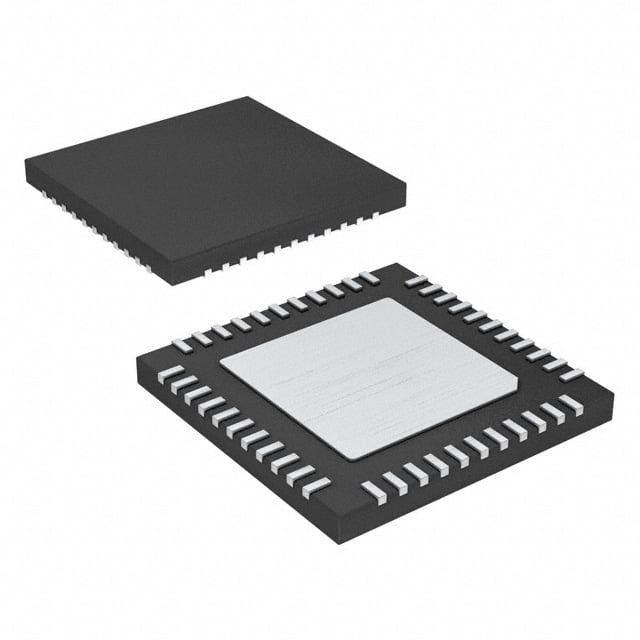PIC18LF4439T-I/ML
Product Overview
- Category: Microcontroller
- Use: Embedded systems, industrial control, consumer electronics
- Characteristics: Low power consumption, high performance, versatile
- Package: 44-pin QFN (Quad Flat No-Lead)
- Essence: A powerful microcontroller with advanced features and capabilities
- Packaging/Quantity: Tray packaging, available in various quantities
Specifications
- Architecture: 8-bit
- CPU Speed: Up to 12 MIPS
- Program Memory Size: 16 KB
- RAM Size: 768 bytes
- Data EEPROM Size: 256 bytes
- Operating Voltage Range: 2.0V to 5.5V
- Digital I/O Pins: 36
- Analog Input Channels: 13
- Timers: 4
- Communication Interfaces: UART, SPI, I2C
- ADC Resolution: 10-bit
- PWM Channels: 2
- Operating Temperature Range: -40°C to +85°C
Pin Configuration
The PIC18LF4439T-I/ML microcontroller has a total of 44 pins. The pin configuration is as follows:
- VDD - Power supply voltage
- RA0 - General-purpose I/O pin
- RA1 - General-purpose I/O pin
- RA2 - General-purpose I/O pin
- RA3 - General-purpose I/O pin
- RA4 - General-purpose I/O pin
- RA5 - General-purpose I/O pin
- MCLR - Master Clear input
- VSS - Ground
- RB0 - General-purpose I/O pin
- RB1 - General-purpose I/O pin
- RB2 - General-purpose I/O pin
- RB3 - General-purpose I/O pin
- RB4 - General-purpose I/O pin
- RB5 - General-purpose I/O pin
- RB6 - General-purpose I/O pin
- RB7 - General-purpose I/O pin
- VSS - Ground
- OSC1 - Oscillator input
- OSC2 - Oscillator output
- RC0 - General-purpose I/O pin
- RC1 - General-purpose I/O pin
- RC2 - General-purpose I/O pin
- RC3 - General-purpose I/O pin
- RC4 - General-purpose I/O pin
- RC5 - General-purpose I/O pin
- RC6 - General-purpose I/O pin
- RC7 - General-purpose I/O pin
- VDD - Power supply voltage
- RD0 - General-purpose I/O pin
- RD1 - General-purpose I/O pin
- RD2 - General-purpose I/O pin
- RD3 - General-purpose I/O pin
- RD4 - General-purpose I/O pin
- RD5 - General-purpose I/O pin
- RD6 - General-purpose I/O pin
- RD7 - General-purpose I/O pin
- VSS - Ground
- VCAP - External capacitor connection for internal voltage regulator
- AVSS - Analog ground
- AN0 - Analog input channel
- AN1 - Analog input channel
- AN2 - Analog input channel
- AVDD - Analog power supply voltage
Functional Features
- High-performance RISC CPU
- Enhanced Flash program memory
- Low-power consumption modes
- Multiple communication interfaces
- Analog-to-Digital Converter (ADC)
- Pulse Width Modulation (PWM)
- Timers and counters
- Interrupt capability
- Watchdog Timer (WDT)
- Brown-out Reset (BOR)
Advantages and Disadvantages
Advantages: - High-performance CPU for efficient processing - Versatile communication interfaces for connectivity - Low-power consumption for energy efficiency - Ample program memory and RAM for complex applications - Wide operating voltage range for flexibility
Disadvantages: - Limited program memory size compared to some other microcontrollers - Limited number of PWM channels
Working Principles
The PIC18LF4439T-I/ML microcontroller operates based on the principles of a RISC (Reduced Instruction Set Computer) architecture. It executes instructions stored in its Flash program memory, performs calculations, controls I/O operations, and communicates with external devices through various interfaces. The microcontroller can be programmed using high-level languages such as C or assembly language.
Detailed Application Field Plans
The PIC18LF4439T-I/ML microcontroller finds applications in various fields, including:
- Embedded Systems: Used in automotive electronics, industrial automation, and home appliances.
- Industrial Control: Enables control and monitoring of machinery, process automation, and data acquisition.
- Consumer Electronics: Used in smart devices, IoT applications, and home
Senaraikan 10 soalan dan jawapan biasa yang berkaitan dengan aplikasi PIC18LF4439T-I/ML dalam penyelesaian teknikal
What is the maximum operating frequency of PIC18LF4439T-I/ML?
- The maximum operating frequency of PIC18LF4439T-I/ML is 40 MHz.
What are the key features of PIC18LF4439T-I/ML?
- Some key features of PIC18LF4439T-I/ML include 16KB flash memory, 256 bytes of EEPROM data memory, and 1.5 KB of SRAM.
Can PIC18LF4439T-I/ML be used in battery-powered applications?
- Yes, PIC18LF4439T-I/ML can be used in battery-powered applications as it has low power consumption features.
What communication interfaces does PIC18LF4439T-I/ML support?
- PIC18LF4439T-I/ML supports SPI, I2C, and UART communication interfaces.
Is PIC18LF4439T-I/ML suitable for industrial control applications?
- Yes, PIC18LF4439T-I/ML is suitable for industrial control applications due to its robust features and performance.
Does PIC18LF4439T-I/ML have built-in analog-to-digital converters (ADC)?
- Yes, PIC18LF4439T-I/ML has a 10-bit ADC with up to 13 channels.
What development tools are available for programming PIC18LF4439T-I/ML?
- Development tools such as MPLAB X IDE and PICkit programmers are commonly used for programming PIC18LF4439T-I/ML.
Can PIC18LF4439T-I/ML be used in automotive electronics applications?
- Yes, PIC18LF4439T-I/ML can be used in automotive electronics applications due to its wide operating voltage range and robust design.
What are the temperature specifications for PIC18LF4439T-I/ML?
- PIC18LF4439T-I/ML has an extended temperature range of -40°C to 125°C.
Are there any known limitations or common issues when using PIC18LF4439T-I/ML?
- While PIC18LF4439T-I/ML is a reliable microcontroller, some users have reported issues with certain peripheral configurations, so thorough testing is recommended.


